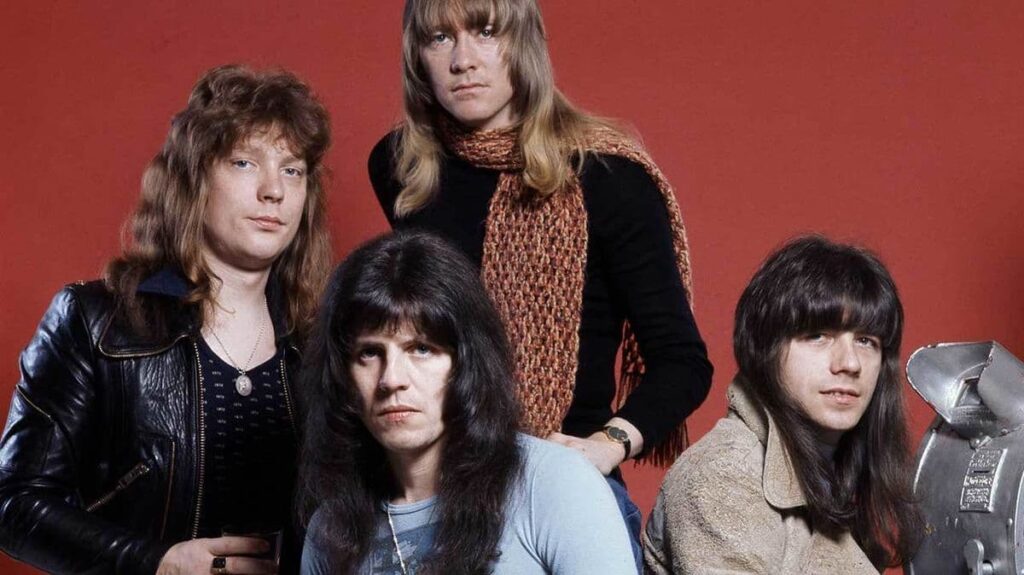
Sweet’s “Cockroach”: A Deep Dive into a Gritty, Unsung Glam Rock Gem
For those of us who came of age amidst the glitter and thunder of 70s rock, the name Sweet conjures images of flamboyant outfits, soaring harmonies, and a swagger that few bands could match. While their chart-topping hits like “Ballroom Blitz” and “Fox on the Run” are etched into the collective memory of a generation, it’s in their album tracks that the true depth and sometimes surprising grit of Sweet often revealed itself. One such track, often overlooked in favor of their more accessible singles, is “Cockroach.” Released in 1976 on their album Give Us A Wink, “Cockroach” was never a single and, consequently, never charted in its own right. Yet, for the dedicated fans who ventured beyond the radio waves, it offered a different facet of the band’s evolving sound.
The story behind “Cockroach” is less about a specific anecdote and more about the band’s creative journey during a pivotal period. By 1976, Sweet was actively shedding the “bubblegum glam” label that had initially defined them. They were keen to prove their mettle as serious musicians and songwriters, pushing beyond the pop constraints imposed by their earlier producers. Give Us A Wink was their second self-produced album, a testament to their desire for greater artistic control. “Cockroach,” with its heavier riffs and darker lyrical themes, stands as a prime example of this transition. It was a conscious effort to move towards a more hard rock sound, aligning them more closely with acts like Led Zeppelin or Deep Purple, while still retaining a touch of that unmistakable Sweet melodicism.
The meaning of “Cockroach” is open to interpretation, as often happens with lyrics that lean into metaphor rather than narrative. However, the prevailing sense is one of resilience, survival, and perhaps a commentary on the less glamorous, more persistent aspects of life or even societal underbelly. The cockroach, after all, is a creature known for its uncanny ability to survive harsh conditions, to persist in the face of adversity, and to scuttle unseen in the shadows. Is it a metaphor for the band itself, battling against expectations and critics, constantly adapting and surviving in the cutthroat music industry? Or perhaps it speaks to a more universal human condition, the struggle to endure and find strength amidst the dirt and grime of everyday existence? The lyrics, while not overtly narrative, evoke a sense of creeping unease, a pervasive presence that refuses to be eradicated, mirroring the enduring nature of human will.
Musically, “Cockroach” is a fascinating departure from the more pop-oriented Sweet sound. It opens with a somewhat ominous, almost sludgy guitar riff, immediately signaling a shift in tone. Brian Connolly’s vocals, while still powerful and distinctive, take on a more raw, almost desperate quality, perfectly complementing the grittier instrumentation. The song showcases the formidable talents of Andy Scott on guitar, Steve Priest on bass, and Mick Tucker on drums, allowing them to stretch out and demonstrate their hard rock chops. It’s a track that demands to be listened to with a critical ear, appreciating the musicianship and the deliberate sonic choices made by the band. For those who remember Sweet primarily for their catchy, upbeat singles, “Cockroach” might have been a revelation, a testament to their growth and ambition.
“Cockroach” serves as a reminder that the true essence of a band often lies beyond the radio hits. It’s in these deeper cuts, these album tracks, that artists often reveal their true creative intentions and push the boundaries of their established sound. For older listeners who might have dismissed Sweet as merely a “glam pop” band, revisiting “Cockroach” today offers a chance to appreciate their heavier side, their musicianship, and their determination to evolve. It’s a track that encapsulates the gritty, experimental spirit of 70s rock, a hidden gem that still carries a surprising punch. It reminds us that even in the shimmering world of glam, there were artists unafraid to explore the darker corners, leaving us with enduring, if sometimes uncelebrated, pieces of musical history.